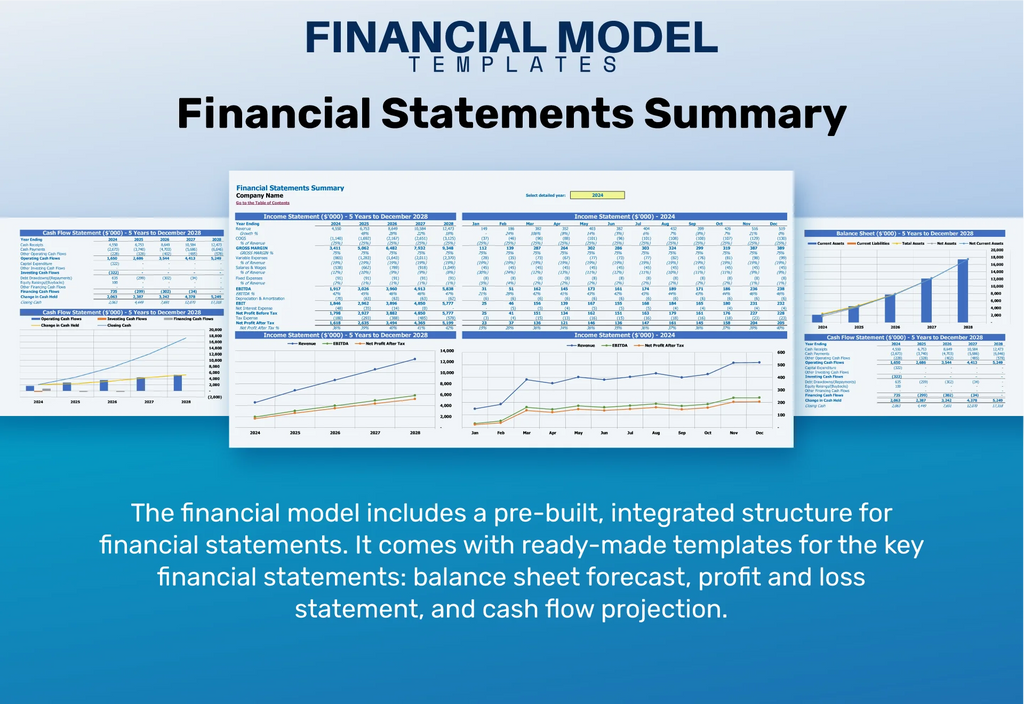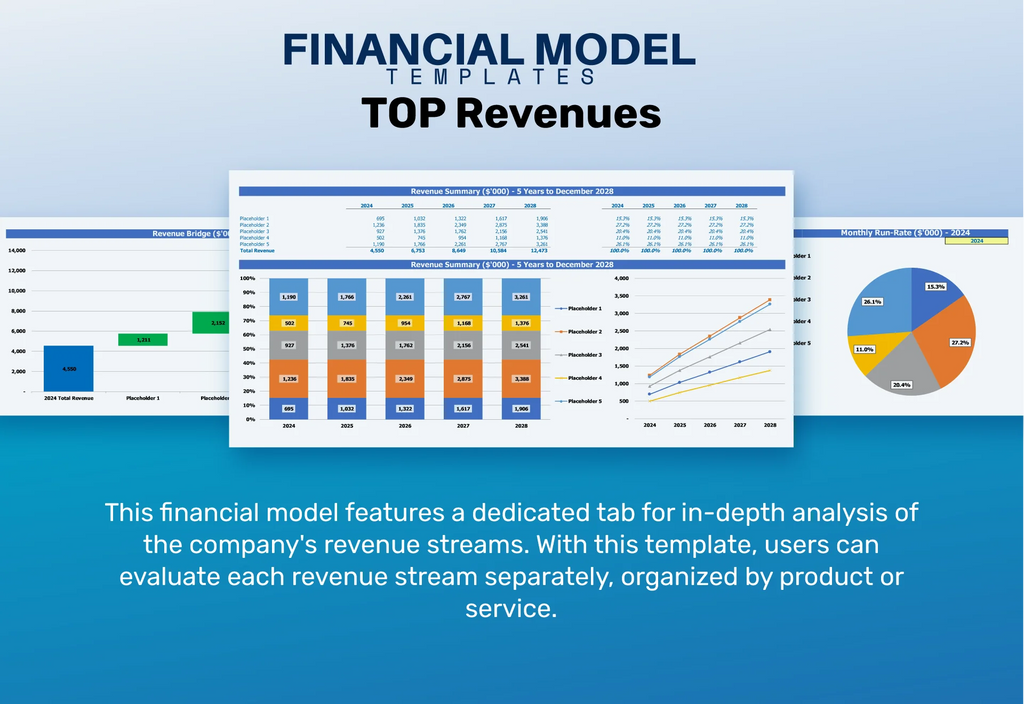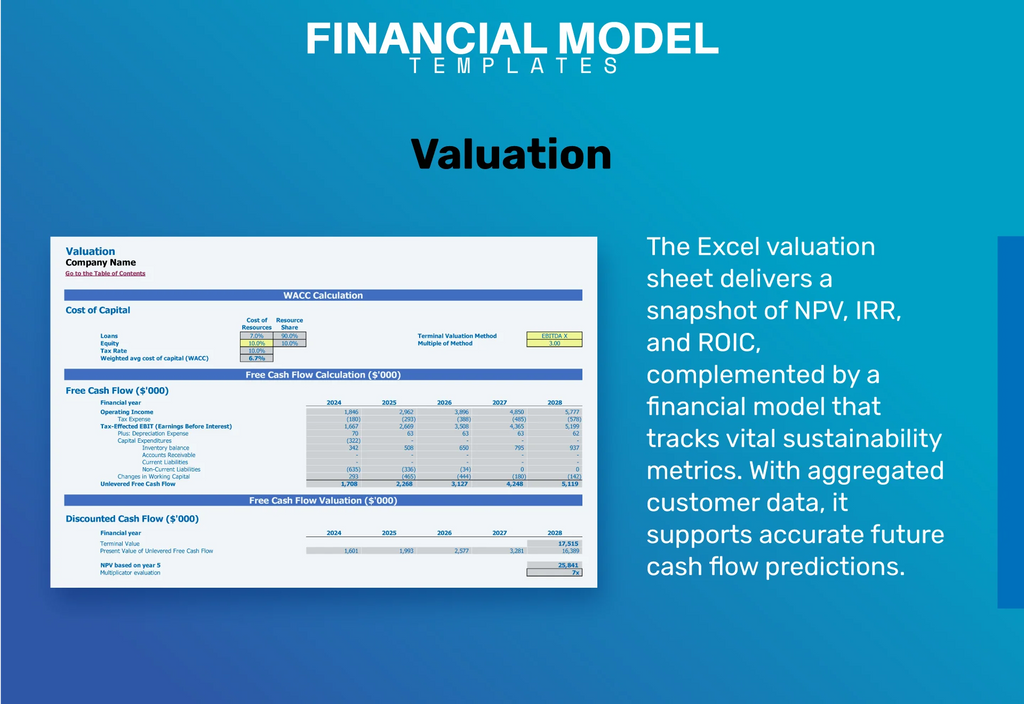Talent Acquisition Financial Model

- ✔ 5-Year Financial Projections
- ✔ 100% Editable
- ✔ Investor-Approved Valuation Models
- ✔ MAC/PC Compatible, Fully Unlocked
- ✔ No Accounting Or Financial Knowledge
Talent Acquisition Financial Model
Bundle Includes:
-
Financial Model
-
Business Plan
-
Pitch Deck
-
Financial Dashboard
ALL IN ONE MEGA PACK - CONSIST OF:
talent acquisition Financial Model/Business Plan Excel Template
Pitch Deck Template For PowerPoint, Keynote & Google Slides
Business Plan Guide and Business Plan Template in MS Word Format
Financial Dashboard in Excel To Track Your Business Performance
TALENT ACQUISITION FINANCIAL MODEL FOR STARTUP INFO
Highlights
Develop a comprehensive 5-year talent acquisition strategy that includes a robust financial model to analyze recruitment financial aspects such as cost per hire, employee lifetime value, and staffing agency cost assessments. This approach integrates a workforce planning model alongside recruitment ROI metrics and labor cost analysis to project the financial implications of staffing decisions. By utilizing a recruitment marketing budget, you can enhance candidate experience investments and perform thorough recruitment funnel analysis to optimize talent sourcing expenditures while considering job market trends. Additionally, the framework allows for the evaluation of diversity hiring financial impacts, employee onboarding expenses, and staff retention costs, ensuring a holistic view of talent management budgeting. With the capacity to generate projected income statements, financial statements, and GAAP or IFRS-compliant financial ratios, this tool is invaluable for assessing the viability of a talent acquisition business prior to sale.
The talent acquisition Excel financial projection model addresses critical pain points in recruitment financial analysis, providing insights into cost per hire, staff retention costs, and employee onboarding expenses. By featuring a comprehensive workforce planning model, it allows users to evaluate recruitment ROI metrics and analyze talent sourcing expenditures effectively. The integrated framework supports human resources financial projections, facilitating salary benchmarking costs and enhancing candidate experience investment. Users benefit from robust recruitment funnel analysis and can assess diversity hiring financial impact, ensuring alignment with job market trends. This holistic approach empowers organizations to optimize talent management budgeting and enhances overall labor cost analysis through sophisticated reporting on employee lifetime value and staffing agency cost assessment.
Description
The Talent Acquisition Excel Financial Model is a versatile tool designed for organizations aiming to develop a comprehensive talent acquisition strategy through detailed financial projections over a 60-month period. It includes essential elements such as recruitment financial analysis, employee lifetime value estimates, and cost per hire metrics, which help streamline workforce planning models and monitor staffing agency cost assessments. The model supports analysis of recruitment ROI metrics, allowing businesses to evaluate their recruitment marketing budget and talent sourcing expenditures, ultimately guiding decisions on employee onboarding expenses and staff retention costs. With integrated workforce analytics frameworks, this financial model equips users to enhance candidate experience investments while accounting for diversity hiring's financial impact, making it a valuable resource for both startups and established firms in navigating job market trends and optimizing their human resources financial projections.
TALENT ACQUISITION FINANCIAL MODEL REPORTS
All in One Place
Navigating talent acquisition strategy can seem daunting, but it's essential for your startup's success. Our comprehensive five-year financial projection equips you with customizable templates and tools tailored for effective workforce planning models. By analyzing recruitment financial analysis, cost per hire, and employee lifetime value, you can optimize your recruitment marketing budget and enhance your recruitment ROI metrics. With a focus on candidate experience investment and diversity hiring financial impact, you'll build a robust recruiting framework. Embrace this opportunity to refine your talent management budgeting and drive sustainable growth for your startup.

Dashboard
The Dashboard tab in the business projection template provides an insightful financial overview through dynamic graphs, charts, and ratios. This comprehensive snapshot includes critical metrics like cost per hire, employee lifetime value, and recruitment ROI, making it an invaluable resource for your talent acquisition strategy. These visuals are designed for easy integration into your pitch deck, ensuring you present a compelling case for informed workforce planning and effective talent management budgeting. Leverage this tool to enhance your recruitment financial analysis and drive impactful hiring decisions.

Business Financial Statements
Each financial statement serves a unique purpose, crucial for a comprehensive analysis of a company's performance. The profit and loss statement highlights income and expenses, revealing the profitability from core operations. The projected balance sheet offers a snapshot of the company's financial standing and capital structure at a specific moment, while the cash flow projection tracks financial influxes and outflows from key activities. Together, these documents contribute to a holistic understanding of the company's financial health, informing strategies in talent acquisition, workforce planning, and overall human resources financial projections.

Sources And Uses Statement
The sources and uses of funds statement in your business plan outlines financing strategies and spending policies. The 'Sources' section reveals your company’s funding channels, such as business loans, investor contributions, and share issuances. Conversely, the 'Uses' section details expenditures, providing stakeholders with insights into costs for land, buildings, equipment, and startup expenses. This transparency fosters confidence and aligns with a robust talent acquisition strategy, allowing for effective workforce planning and recruitment financial analyses. Understanding these elements enhances your organization’s recruitment ROI metrics and overall financial projections.

Break Even Point In Sales Dollars
Breakeven analysis is an essential tool for assessing when a business will cover its expenses and start generating profits. To effectively conduct this analysis, identify both fixed and variable costs. Fixed costs, such as rent and administrative salaries, remain constant regardless of sales volume and are considered overhead. In contrast, variable costs fluctuate in direct relation to sales, encompassing expenses like inventory purchases, shipping, or manufacturing. By understanding these financial dynamics, organizations can enhance their talent acquisition strategy and optimize recruitment ROI metrics, ensuring a sustainable workforce planning model.

Top Revenue
The Top Revenue tab empowers you to generate demand reports for your café products and services while offering insights into profitability and key financial metrics based on your assumptions. Utilize the straightforward financial projections template to delve into revenue depths and bridges, allowing for analysis of various timeframes, such as weekdays versus weekends. With these comprehensive revenue reports, you can refine your workforce planning model, optimize talent acquisition strategy, and ensure you have the right resources in place when needed, ultimately enhancing your operational efficiency and decision-making.

Business Top Expenses Spreadsheet
Effective cost management is crucial for both startups and established companies to ensure profitability. A robust talent acquisition strategy, alongside recruitment financial analysis, can significantly optimize expenses. Our Excel pro forma template features a Top Expense Report that identifies the four largest expense categories and encompasses others as 'other.’ This streamlined approach enables users to monitor key metrics, such as cost per hire and employee onboarding expenses, while tracking trends year-over-year. By focusing on optimizing these areas, organizations can enhance their recruitment ROI metrics and overall financial health.

TALENT ACQUISITION FINANCIAL PROJECTION EXPENSES
Costs
The talent acquisition startup financial model in Excel is vital for identifying both actual and projected expenditures, along with the necessary financial resources to manage these costs. By developing a comprehensive recruitment financial analysis, you can pinpoint opportunities for savings and prioritize critical areas. This cost budget serves as an essential component of your business plan, enhancing your pitch to investors and strengthening loan applications. Leveraging ROI metrics and workforce analytics frameworks, you can optimize your recruitment marketing budget and ensure effective workforce planning for sustainable growth.

CAPEX Spending
Capital expenditure (CAPEX) plays a pivotal role in robust financial forecasting for organizations. Financial experts meticulously analyze CAPEX to oversee investments in fixed assets, ensuring effective management of depreciation, and tracking additions or disposals of property, plant, and equipment. It is crucial to incorporate initial startup costs, including financial leases, into comprehensive workforce planning models. By aligning talent acquisition strategies with CAPEX insights, companies can enhance recruitment ROI metrics, optimize employee onboarding expenses, and ultimately boost employee lifetime value, contributing to a more efficient and financially sound workforce.

Loan Financing Calculator
Similar to the structured approach in talent acquisition strategy, a loan amortization plan spreads repayment across designated periods. This involves a series of consistent payments that align with the organization’s financial projections. Companies typically execute these payments monthly; however, they may also opt for quarterly or annual intervals. Just as effective workforce planning models optimize costs per hire and enhance recruitment ROI metrics, a strategic loan amortization framework ensures financial stability and long-term growth, ultimately benefiting the overall organizational budget and employee value.

TALENT ACQUISITION EXCEL FINANCIAL MODEL METRICS
Financial KPIs
EBIT, or earnings before interest and taxes, serves as a key profitability metric for assessing a company's financial health. By evaluating operating income, it considers essential factors like operating expenses, cost of sales, and external financial obligations. For organizations focused on talent acquisition strategy, understanding EBIT is crucial for analyzing recruitment financial analysis, workforce planning models, and staffing agency cost assessments. This comprehensive insight informs recruitment ROI metrics and aids in aligning talent management budgeting with overall business goals, ultimately enhancing employee lifetime value and optimizing costs.

Cash Flow Forecast Excel
The cash flow forecast is an essential financial statement for startups, detailing cash inflows and outflows. When combined with the pro forma balance sheet and profit and loss statement, it forms a crucial part of financial reporting. This projection allows organizations to analyze their cash movement, closely linking it to their talent acquisition strategy and employee onboarding expenses. By using a monthly cash flow statement format, companies can better understand their financial health, enabling informed decisions on workforce planning, recruitment marketing budgets, and other talent management budgeting efforts for improved staffing agency cost assessment and overall recruitment ROI metrics.

KPI Benchmarks
The financial plan’s Excel benchmark tab assesses a company’s performance, laying the groundwork for a competitive analysis. By evaluating key recruitment ROI metrics and labor cost analysis, startups can refine their talent acquisition strategy and enhance employee onboarding expenses. Tracking essential indicators, such as job market trends and staffing agency cost assessments, ensures organizations remain agile and informed. This proactive approach to workforce planning models not only drives effective talent management budgeting but also enhances the overall candidate experience, ultimately impacting employee lifetime value and staff retention costs positively.

P&L Statement Excel
The monthly profit and loss statement template is essential for effective talent acquisition strategy. By incorporating detailed revenue streams and rigorous cost per hire analysis, it provides valuable insights into recruitment financial analysis. This tool empowers businesses to assess employee lifetime value and improve talent management budgeting. Additionally, the yearly profit and loss forecast offers a comprehensive overview of labor cost analysis, along with key metrics like recruitment ROI and candidate experience investment. With integrated graphs and assumptions, it enables organizations to stay ahead of job market trends, ensuring optimal workforce planning and staffing agency cost assessment.

Pro Forma Balance Sheet Template Excel
The projected balance sheet for a startup provides a concise snapshot of total assets, liabilities, and shareholders' equity at a specific point in time. This pro forma balance sheet not only reflects what the company owns and owes, but also offers valuable insights into financial health by comparing past performance. With a focus on effective talent acquisition strategy and recruitment financial analysis, our framework enables informed decisions on staffing agency cost assessments and employee onboarding expenses. This strategic approach ultimately enhances recruitment ROI metrics and employee lifetime value, ensuring sustainable growth and a competitive edge in the job market.

TALENT ACQUISITION FINANCIAL PROJECTION TEMPLATE VALUATION
Startup Valuation Model
This business financial model template includes a comprehensive valuation report, enabling users to execute a Discounted Cash Flow analysis effortlessly with minimal input on the Cost of Capital. By integrating key components such as talent acquisition strategy and workforce analytics framework, organizations can optimize recruitment financial analysis and assess their recruitment ROI metrics. This invaluable tool allows for strategic planning, addressing crucial factors like employee lifetime value and staffing agency cost assessment, ultimately enhancing your talent management budgeting and decision-making processes. Unlock insights into job market trends and improve your hiring outcomes with this robust model.

Cap Table
This feasibility study template Excel facilitates robust financial analysis, incorporating cash flow statements and monthly profit and loss evaluations. It features a capitalization table essential for forecasting key metrics such as employee lifetime value and recruitment ROI. Additionally, the business plan financial projections template helps assess sales and EBITDA, providing insights into talent acquisition strategy and workforce planning. With tools for recruitment funnel analysis and job market trends, this template supports informed decision-making in talent management budgeting and staffing agency cost assessments, ultimately enhancing your investment evaluation process.

KEY FEATURES
An effective workforce planning model enhances recruitment ROI metrics, optimizing talent acquisition strategy and reducing overall hiring costs.
This talent acquisition financial model offers quick, reliable insights, enhancing your recruitment strategy's effectiveness regardless of your business size.
An effective workforce planning model enhances recruitment ROI metrics, optimizing talent acquisition strategy and reducing overall hiring costs.
This advanced talent acquisition financial model empowers businesses to optimize recruitment costs and enhance employee lifetime value effortlessly.
Implementing a robust workforce planning model enhances recruitment ROI metrics and minimizes staffing agency costs for greater financial stability.
Implementing a robust workforce planning model enhances financial forecasts, ensuring optimal recruitment costs and improved employee lifetime value.
Implementing a workforce analytics framework helps identify cash gaps and surpluses, enhancing your talent acquisition strategy's financial efficiency.
Implementing a workforce planning model enables proactive financial management, ensuring optimal resource allocation and enhanced recruitment ROI metrics.
Implementing a robust workforce analytics framework enhances our talent acquisition strategy, maximizing recruitment ROI and ensuring great value for money.
Leverage our robust talent acquisition financial model for strategic insights, ensuring effective budgeting and maximizing recruitment ROI with transparency.
ADVANTAGES
A robust financial model enhances your talent acquisition strategy by pinpointing strengths and weaknesses, optimizing recruitment ROI metrics and costs.
A robust financial model for talent acquisition strategy enhances decision-making by optimizing recruitment ROI metrics and controlling costs effectively.
Implementing a robust talent acquisition financial model enhances recruitment ROI metrics, optimizing workforce planning and reducing overall hiring costs.
Effectively managing your talent acquisition strategy enhances recruitment ROI metrics, optimizing costs while improving the overall candidate experience investment.
Enhance your talent acquisition strategy by utilizing a financial model to optimize recruitment costs and boost employee lifetime value.




